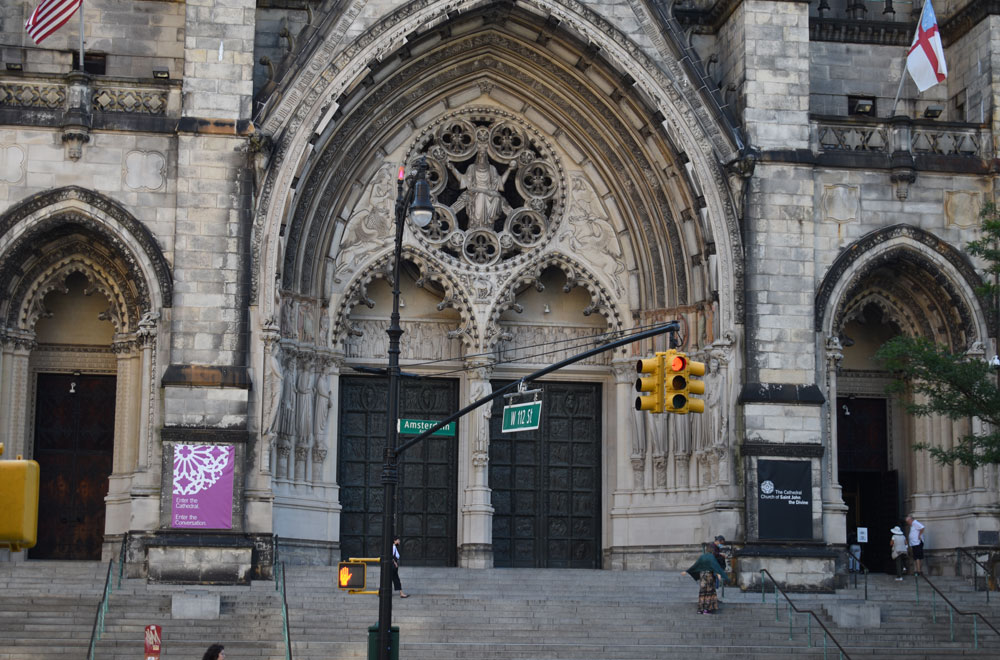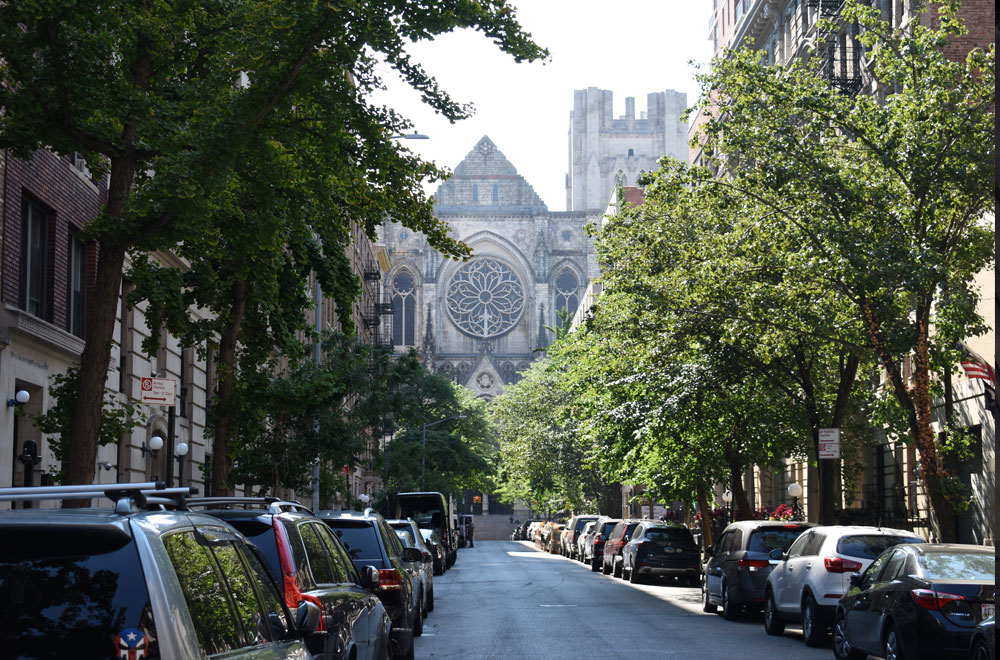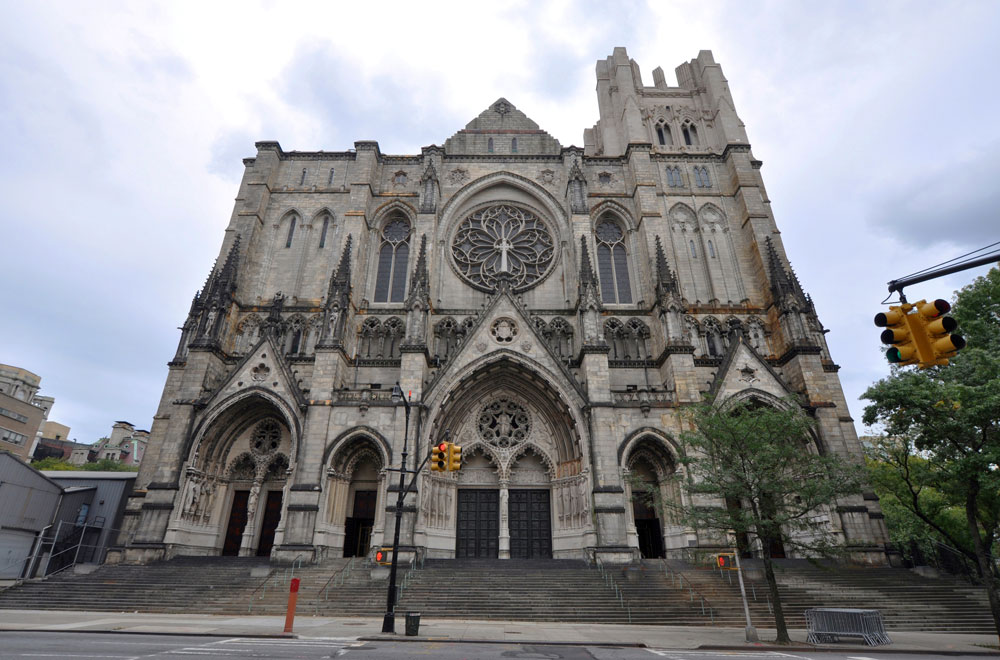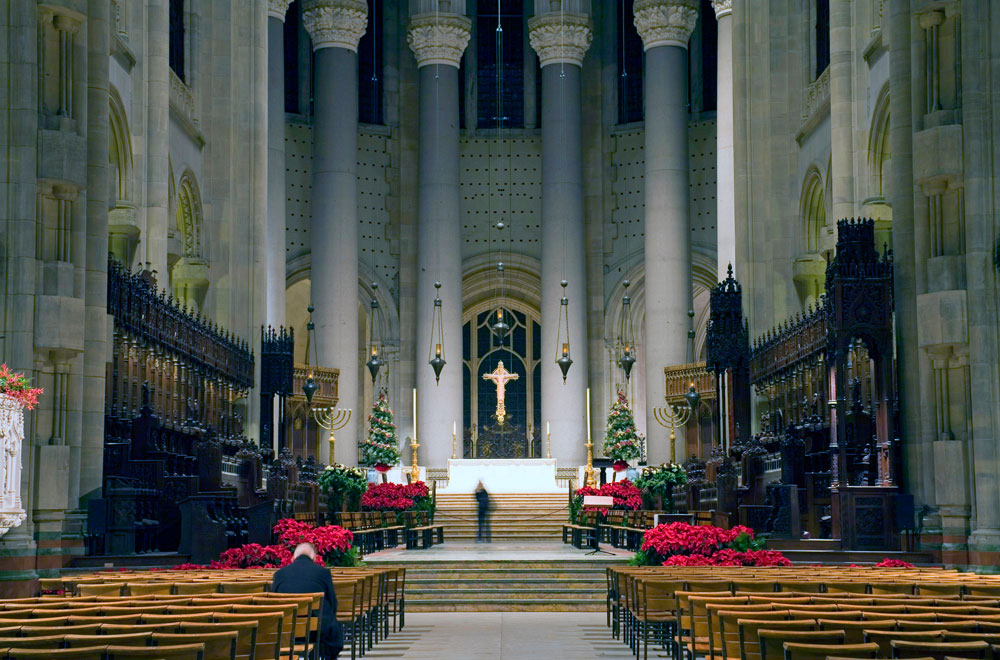Cathedral of St. John the Divine
The Cathedral of St. John the Divine is the cathedral of the Diocese of New York.
It is located on Amsterdam Avenue between West 110th Street and 113th Street in the Morningside Heights neighborhood of Manhattan.
The cathedral competes with Liverpool Cathedral for the title of largest Anglican cathedral and church. It is also the fourth largest Christian church in the world. The interior covers 11,200 square meters, extending to a length of 183.2 meters and a height of 70.7 meters. The internal height of the main church is 37.8 meters.
The cathedral, designed in 1888 and begun in 1892, has undergone radical stylistic changes and two interruptions during the two World Wars. It was originally designed in a Byzantine-Romanesque Revival style, but the design was changed after 1909 to a Gothic Revival design.
After a major fire on December 18, 2001, it was closed for repairs and reopened in November 2008. It remains unfinished, with construction and restoration an ongoing process. Therefore, you often give him the nickname “Saint John the Unfinished”.

History of the Cathedral of St. John the Divine
In 1887 Bishop Henry Codman Potter of the Diocese of New York asked for a cathedral to compete with St. Patrick’s Cathedral in Manhattan. A 46-acre property, which housed the Leake and Watts orphanages, was purchased for the construction of the cathedral in 1891. After an open competition, a design by the New York firm of George Lewis Heins and C. Grant Lafarge in a Byzantine- Romanesque style was adopted the following year.
Construction on the cathedral began with the laying of the cornerstone on 27 December 1892, St John’s Day, when Bishop Henry Potter struck a stone three times with a gavel. The foundations were completed at prohibitive cost because the bedrock was not drilled until the excavation reached 22 meters.
Built around eight solid, 130-ton, 15-meter granite columns sourced from Vinalhaven, Maine, the walls were said to be the largest in the world. The columns, transported to New York on a purpose-built barge pulled by the large steam tug Clara Clarita, took more than a year to install.
The first services were held in the crypt, under the passage in 1899. The Ardolino brothers from Torre di Nocelli, Italy, did much of the stone carving work on the statues designed by the English sculptor John Angel. After the completion of the large central dome, with Guastavino tiles, in 1909, the original Byzantine-Romanesque design was changed to a Gothic style.

Increasing friction after Heins’ untimely death in 1907 eventually led the commissioners to dismiss the surviving architect, Christopher Grant LaFarge, and hire noted Gothic Revival architect Ralph Adams Cram to design the nave and “Gothicize” it. those that Lafarge had already manufactured. In 1911, the seating area and passage were opened, and in 1916 excavation of the foundations for Cram’s main temple began.
In 1925 the first stone of the main church was laid and the western facade was completed. Bishop William T. Manning announced a campaign to raise a $10,000,000 fund for the project at a major press conference.
The New York campaign committee was headed by Franklin D. Roosevelt. Work on the church during the Great Depression was proceeding normally as a result of the money raised by this campaign.
The first opening
The cathedral opened, before it was completed, for the first time on November 30, 1941, a week before the bombing of Pearl Harbor. Construction was then halted because the then-Bishop felt that the church’s funds would be better spent on charitable works, and because the subsequent involvement of the United States in World War II had severely limited the manpower available.
Although Cram intended to dismantle the dome and build a massive Gothic tower in its place, this plan was never carried out. The result was that the cathedral reflected a mixture of architectural styles, with a Gothic nave, a Romanesque passage under the dome, chapels in the French, English and Spanish Gothic styles, as well as Norman and Byzantine. Gothic pews of the sitting room and Romanesque arches and columns separated the high altar from its rear.
The Reverend James Parks Morton, who became dean of the cathedral in 1972, promoted plans to make it “a holy place for the whole city” and encouraged a renaissance in cathedral building.

In 1979 the bishop at the time, Right Reverend Paul Moore, Jr, decided that construction should continue, in part to preserve the stone industry and to train the youth of the neighborhood, thereby providing them with a valuable skill.
In 1979, Mayor Ed Koch joked at the dedication ceremony: “I’m told that some of the great cathedrals took over five hundred years to build. but I would like to remind you that we are only in our first hundred years”.
Construction of the south tower continued for several years in the 1980s, during which another 15 meters in height was proposed, in limestone rather than granite as in the original construction. After this initiative was abandoned, the scaffolding erected around the south tower remained and rusted until it was removed in the summer of 2007.
Under master stone carvers Simon Verity and Jean Claude Marchionni, work on the statues of the central portal of the west facade of the cathedral was completed in 1997.
The cathedral saw no further construction and the new generation of trained stone carvers moved on to other projects. On December 18, 2001, a major fire destroyed the north main church and covered the church organ with soot.

The great western doors of the Cathedral of St. John the Divine
The large west doors on Amsterdam Avenue were designed between 1927 and 1931 by the designer Henry Wilson. The bronze doors were installed in 1936. The sequence of 48 relief panels depicts scenes from the Old and New Testaments and the Apocalypse.
In his lifetime, Henry Wilson produced only four sets of bronze doors: for St Mary’s Church in Nottingham, the chapel at Welbeck Abbey, the Salada Tea Company in Boston and those for the cathedral. These were the last of the four commissions on a monumental scale, measuring approximately 5.5 by 3.6 meters.
They came at the end of Henry Wilson’s life and were the pinnacle of his career. He died shortly afterwards in Menton, France, in 1934.

21st century
In 2001 the choir parapet was completed with the addition of a sculpture by Chris Pelletierri depicting a group of four figures: Martin Luther King, Albert Einstein, Susan B. Anthony and Mohandas Gandhi.
The parapet was originally installed in 1922 with twenty niches for statues of the spiritual heroes of the twenty centuries since the birth of Christianity. Representing the 17th, 18th and 19th centuries are statues of William Shakespeare, George Washington and Abraham Lincoln. The seat for the 20th century remained vacant until the century was completed.
On the morning of December 18, 2001, a fire swept through the unfinished north transept, destroying the gift shop and for a time threatening the sanctuary of the cathedral itself. Temporarily silenced the Aeolian-Skinner church organ.
Although the instrument was not destroyed, all pipes and other parts had to be removed, cleaned and restored, to prevent damage from the accumulated soot of the fire. Valuable tapestries and other items in the cathedral suffered smoke damage.
In January 2005, the cathedral began a major restoration, which was completed and the cathedral rededicated on Sunday, November 30, 2008.
A chemical-based cleaning system was used, not only to remove the smoke damage from the 2001 fire, but also the dark atmosphere of the 80-year-old air, which filled the interior with a strange light.
In 2008, the cathedral leased the southeast corner of its property, which contained the cathedral playground and Rose Garden, to the AvalonBay community. A modern, glass condo tower, Avalon Morningside Park now occupies the space.


